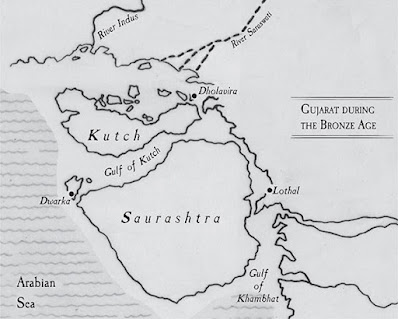The Merchants of Meluhha
- traditional view discovers agriculture in the Middle east
- maybe true for Europe as well
- Biblical View - civilization began in middle east
- farming emerged independently in many parts of the World
India's Early Farmers
- Baluchistan - in excavation - first place in subcontinent to witness agriculture base settlements
- Mehrgarh in the BoganValeey (documented site - 8000 years before)
- Early layers - bones of animals like Gazelle, spotted dear, sambar, blackbuck, nilgai, wild ass and elephants
- some of above cant thrive in Present Baluchistan
- Later layers - mix gradually switches to cattle, goat and sheep
- Barley first crop, wheat later
- Recent Study - Farming appeared more or less simultaneously in number of cluster in Northern India
- Animal bones found in Central India as well (Horses painted on rocks of Bhimbetka, stone Age site South of Madhya Pradesh)
- Indians familiar with Horses suggested we domesticated against the view that says animals domesticated in Central Asia than came here in Iron Age
- South India - farming came late, or sites have been washed away or choice between catching fish and seeing vegetables grow
The Rivers of Civilization
- Indian subcontinent witness growth on two rivers - Indus and dry bed of Ghaggar
- Ghaggar - Emerged from Himalaya near modern day Chandigarh --> Haryana ---> Rajasthan ---> Sindh ---> Rann of Kutch - Sea
- Accepted now Ghaggar is Saraswati.
- more settlement on Saraswati bank than Indus river
- Indus Valley Civilization - Harappan
- Saraswati and Ghaggar - Carbon Dating - 7000 B.C. almost same as oldest site in Baluchistan
- Monsoon gradually started weaken - 5000 B.C
- 3200 B.C - Egypt unified, Large settlements in Saraswati and Indus Basins - 2600 B.C
- 2600 - 2000 B.C - Mature Harappan period - rise of major cities Mohenjodaro, Harappa, Dholavira, Kalibangan, etc
- 2000 B.C. - cities declined
- Harappan didnt built Piramids but Cities were sophisticated and spread is very very large upto Gujarat
The Maritime Hub of Dholavira
- Rann of Kutch get water from Indus and Saraswati
- Sea level at Harappans was several metres higher than today - Saurashtra Peninsula was Island - ships can enter Rann of Kutchh and exit to Gulf of of Khambhat
- 2600 B.C. Saraswati began to dry
- Tectonic shifted Sutlej to Indus and Yamuna to Ganga
- Mature Harappan period started when Saraswati started dying
- Trade major influencer in Persian Gulf
- Harappan weights and measures were Standard across region
- Locals copied Harappan seals
- till 1960s Indian Rupee was used as legal tender in Oman, Qatar, Bahrain and UAE
Did the Harappans Compose the Vedas?
- Traditional view Rig-Veda composed by so-called Aryans in 1500 B.C from Central Asia.
- date is arbitrary no archaelogical or genetic sign of a large scale invasion/migration
- Rig-Veda no mention of Central Asia, geographically concerns with only Sapta Sindhu or Land of Seven Rivers (Haryana and some regions of Punjab & Rajasthan)
- Original land of Bharat tribe than defeated an alliance of ten tribe on banks of Ravi in Punjab, expended to east along Yamuna and created first known Empire Bharatas
- Harappan people derived from ANI gene pool
- Rig Veda - Saraswati as the greatest rivers. 45 hyms for it and hardly 2 for Ganga. No mention of drying of Saraswati so should be at least written 2600 B.C. . So its pre Harappan text.
The Churning of Genes
- Harappan cities flourished till 2000 B.C. Due to climate change this Bronze Age civilization was impacted
- Similar climate change happened in Egypt and Mesopotamia
- Post Vedic text describe Saraswati disappeared underground
- Some people migrated to Himalaya foothills and gangetic plains. From Gujarat -> South to Narmada and Tapti valley
- ANI Genes -> South and East, ASI -> North
- Present day major population belongs to this mixed gene of ANI and ASI
- Mainstream historians - Unidirectional flow of culture and Technology from North-West of India to east and South
- Varanasi is as old as Harappan
- Bronze Age bypassed Southern India. In Late 3rd Millenium B.C. they invented Iron.
- Traditional view invaders from Central Asia introduced Iron
- University of Hyderabad in 2014-15 discovered in their campus iron artifacts including weapons dated around 2400-1800 B.C.
The Indo-Iranians
- Oldest Zoroastrianism, religion of ancient Persia, composed in language similar to Vedic Sanskrit. They follow rituals and customs like fire sacrifice and sacred thread.
- Unlike Vedic text they refer to "Original Land". They have knowledge of Saraswati and Sapta Sindhu.
- Perhaps Persian are descendants of Parsu tribe part of ten tribe defeated by Bharatas tribe.
- Gouda Brahmins from Banks for Sarawati-> Bengal --> Western Coast (oral histories)
- Vedic Mitanni god Mitra - popular deity in Middle East . Romans (God - Solar god Mitras)
- Pagan Romans -> festival Saturnalia for a week from 17th Dec - 25th Dec. Christians converted and kept the popular festival and choose 25 Dec as Jesus birthday which is not accepted by Orthodox Church still celebrate birthday on 7th January
The Daughters of Chitrangada
- Matrilineal customs - Khasis of Meghalaya
- Assam - Sindoor is applied by mother-in-law instead of husband
- Mahabharata - Arjun visited kingdom of Manipur and marries Princess Chitrangada. Condition - she will not follow him back as she and her children were heirs of throne
